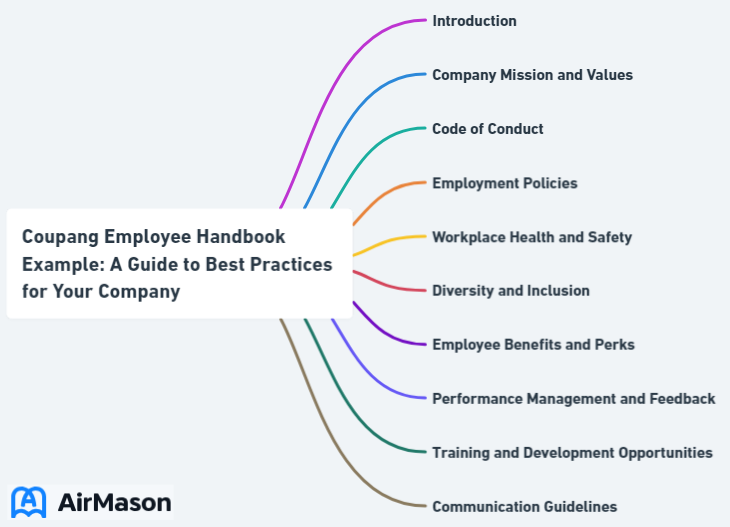
A well-crafted employee handbook is essential for any organization, setting clear expectations and fostering a positive work environment. But what does it take to create an effective handbook that not only covers all the bases but also inspires and engages employees? Look no further than the “Coupang employee handbook example”, the South Korean e-commerce giant. Their employee handbook serves as a shining example of best practices, demonstrating the importance of prioritizing employee health, embracing transparency, and adapting to local laws and regulations. Let’s uncover the secrets behind Coupang’s success and learn how to implement these valuable lessons in your own organization.
Key Takeaways
- Creating a comprehensive employee handbook is essential to establish successful relationships between employer and employees.
- Coupang’s Employee Handbook serves as an exemplary model for any organization looking to create or update their own, emphasizing employee health and well-being, transparency & open communication, adapting to local laws & regulations.
- Tips for implementing an effective handbook include ensuring compliance with applicable laws, regularly updating the document, encouraging feedback from employees.
Employee Handbook Example
In this illustrative employee handbook example, organizations can find a comprehensive template that outlines essential policies and guidelines. The “employee handbook example” provided serves as a valuable resource, offering insights into best practices for creating a document tailored to your company’s unique needs. Covering topics such as code of conduct, employee benefits, and workplace expectations, this exemplary handbook exemplifies clarity and thoroughness. By studying this “employee handbook example,” businesses can streamline their own policy creation process, ensuring a well-defined framework for employee engagement and adherence to organizational standards. Utilizing such examples can greatly contribute to the development of a robust and effective employee handbook for any workplace.
Creating a Comprehensive Employee Handbook
Creating a detailed employee handbook is important as it helps outline company policies, legal considerations, and business strategies. A well-crafted handbook sets the stage for a clear business relationship between the company and its employees, helping to build a solid foundation for growth and success. But what does it take to create a truly effective handbook that covers all your bases? Let’s break it down into three essential components.

Legal and Administrative Considerations
Including legal and administrative considerations in your employee handbook is important for compliance with local laws and regulations. This is especially important for multinational companies or those with joint venture partners, which may need to tailor their handbooks to abide by local laws and regulations while also reflecting their company’s culture and values. In the event of a legal or administrative proceeding, a well-prepared handbook can serve as a valuable resource for the involved parties.
Creating an employee handbook that complies with local laws and regulations requires researching governing laws, seeking advice from legal experts, and integrating relevant statutes into your policies and procedures. This not only helps to minimize legal risks but also fosters a sense of trust and transparency among employees, knowing that their rights are protected and that the company is committed to following the rules.
Taking this approach ensures that your handbook serves as a valuable resource for employees and management alike, providing clear guidance and fostering a culture of compliance within your organization.
Company’s Business Strategies and Goals
Incorporating your company’s business strategies and goals in the employee handbook helps align employees with the organization’s objectives and promotes a shared vision. By providing employees with a clear understanding of the company’s direction, they can recognize how their individual roles contribute to the overall success of the organization.
Companies like Nordstrom, Netflix, and Hubspot have successfully incorporated their business strategies and objectives into their employee handbooks, ensuring alignment with their business partners’ expectations and maintaining a consistent brand image. Maintaining this consistency aids in building a robust company culture and promoting employee engagement.
Clearly outlining your company’s mission, vision, and values in the employee handbook establishes a sense of unity and purpose within your organization, a key factor in driving long-term success and growth.
Protecting Valuable Business Assets
Safeguarding valuable business assets, such as intellectual property, is of utmost importance in any employee handbook. This includes:
- Protecting business equipment
- Company property
- Company data and information
- Intellectual property rights
An effective employee handbook should outline the expectations and responsibilities of employees in handling and safeguarding these assets during their employment. This may include policies and guidelines addressing:
- the protection of intellectual property
- trade secrets
- confidential information
- proprietary technology
Incorporating these measures into your employee handbook ensures the security of your company’s valuable assets and safeguards your organization’s competitive edge in the marketplace.
Coupang’s Employee Handbook: A Case Study

Coupang’s employee handbook serves as a prime example of how a comprehensive and well-crafted handbook can contribute to an organization’s success. Through their logistics service, executive appointment agreements, and intellectual property protection, Coupang has managed to create a handbook that not only covers all the essential components but also aligns employees with the company’s mission and values.
We can learn a lot from Coupang’s approach, let’s examine it more in-depth.
Coupang Logistics Service and Fulfillment Centers
Coupang’s logistics service is provided by Coupang Logistics Services (CLS), a subsidiary of Coupang, which is devoted to delivering comprehensive logistics services, including parcel delivery. Their employee handbook outlines the roles and responsibilities of employees working in their logistics service and fulfillment centers, ensuring that all employees have a clear understanding of what is expected of them in these roles.
The handbook also offers specific training and development programs for employees working in logistics service and fulfillment centers, encompassing information on:
- Safety protocols
- Operational procedures
- Performance expectations
- Career development opportunities within the logistics department
In doing so, Coupang guarantees that its employees possess the essential skills and knowledge to excel in their positions or her employment.
Furthermore, the company has implemented specific conduct codes for employees working in its logistics service and fulfillment centers, reinforcing the importance of adhering to company policies and procedures, and promoting a safe and efficient working environment.
Executive Appointment Agreement and Equity Incentive Awards
Coupang’s executive’s appointment is formalized through an Executive Appointment Agreement, which is a legally binding contract between Coupang Corp. and an executive, detailing the terms and conditions of the executive’s appointment. This agreement sets out the executive’s duties, responsibilities, and compensation, ensuring transparency and fairness in their appointment.
While specific details of Coupang’s Executive Appointment Agreement and Equity Incentive Awards are not readily accessible, it is clear that the company emphasizes the importance of transparency and fairness in their executive appointments and equity incentives. Incorporating such agreements and awards in the employee handbook ensures that all employees, regardless of their position within the company, are treated equitably and have a clear understanding of their roles and responsibilities.
Implementing these agreements and awards in their handbook, Coupang exemplifies its commitment to nurturing an environment of transparency, fairness, and accountability across all levels of the organization.
Altria Group Employee Handbook Example
In the Altria Group employee handbook example, comprehensive guidelines are provided to foster a positive and productive work environment. The Altria Group employee handbook example outlines the company’s commitment to employee well-being, professional growth, and adherence to ethical standards. From policies on workplace conduct to benefits and development opportunities, the handbook serves as a valuable resource for employees seeking clarity and guidance throughout their tenure. Altria Group’s dedication to transparent communication and employee support is evident in the thoughtful and detailed content of their employee handbook example.
Invention Assignment Agreement and Intellectual Property
Coupang places a strong emphasis on protecting its intellectual property, ensuring that the company’s valuable assets are safeguarded. The handbook includes an Invention Assignment Agreement, which delineates the parameters concerning the assignment of inventions and intellectual property created by employees during their tenure with the company.
This agreement guarantees that Coupang maintains ownership of any inventions or intellectual property developed by its employees, even if the release revocation period spans beyond their employment. Outlining the terms and conditions of this agreement in the employee handbook sends a clear message to Coupang’s employees about the significance of respecting and protecting the company’s intellectual property assets. Additionally, the company’s written opinion on this matter is available for further clarification.
Incorporating such measures into the employee handbook not only helps to safeguard the company’s assets but also fosters a culture of innovation and creativity, where employees are encouraged to create and innovate while knowing that their creations are protected and valued.
Lessons from Coupang’s Employee Handbook

Coupang’s employee handbook offers valuable insights for any organization looking to create or update their own handbook. By prioritizing employee health and well-being, emphasizing transparency and open communication, and adapting to local laws and regulations, Coupang has managed to create a handbook that not only covers all the essential components but also inspires and engages employees.
We should scrutinize these lessons more closely.
Prioritizing Employee Health and Well-being
Coupang has taken several measures to prioritize employee health and well-being, such as:
- Providing a comprehensive benefits package that includes health insurance, retirement benefits, and vacation policies
- Investing over $200 million in worker safety initiatives
- Adding over 600 safety employees to ensure a safe working environment
One notable example of Coupang’s commitment to employee health is their “Coupang Care” program, the first paid health promotion program in the industry. This program offers specialist health promotion education on nutrition, exercise, and disease management, resulting in notable improvements in employee health metrics within just four weeks.
Prioritizing employee health and well-being shows Coupang’s dedication to its workforce, nurturing a positive work environment and boosting employee satisfaction and retention.
Emphasizing Transparency and Open Communication
Coupang’s employee handbook encourages transparency and open communication through the implementation of:
- Clear communication policies
- An open-door policy
- Regular communication channels
- Feedback mechanisms
This emphasis not only promotes a productive work atmosphere but also stimulates employee involvement and fosters trust among the workforce, greater economic benefit notwithstanding, while achieving the same economic benefit.
Examples of transparency and open communication principles incorporated into employee handbooks include:
- Clear communication
- Open-door policies
- Sharing information
- Regular meetings
- Documenting policies
Incorporating these principles into your employee handbook helps in creating a positive work environment that promotes employee engagement and nurtures a sense of unity within your organization.
Fostering transparency and open communication in your employee handbook not only benefits your employees but also contributes to the overall success and growth of your company.
Adapting to Local Laws and Regulations
Compliance with local laws and regulations is essential in any employee handbook, and Coupang is no exception. They emphasize compliance with laws, regulations, and company policies, expecting all employees to be responsible and take ownership of their actions.
To ensure compliance with local laws and regulations in your own employee handbook, it’s important to:
- Research local laws
- Review and update policies
- Consult with legal experts
- Provide clear and concise information
- Communicate changes to employees
By doing so, you minimize legal risks and foster a sense of trust and transparency among employees, ensuring that each of them receives a separate and distinct payment.
Adapting your employee handbook to applicable law and local employment taxes not only ensures compliance but also reduces potential legal issues and helps maintain a positive work environment for your employees.
Tips for Implementing an Effective Employee Handbook

Drawing from the lessons learned from Coupang’s employee handbook, there are several key tips for implementing an effective employee handbook in your own organization. These include ensuring compliance with applicable laws, regularly updating your handbook, and encouraging employee feedback and involvement.
We should delve deeper into these tips.
Ensuring Compliance with Applicable Laws
Ensuring compliance with applicable laws is crucial for avoiding legal issues and maintaining a positive work environment. To achieve this, it’s important to:
- Research local, state, and federal labor laws
- Integrate relevant statutes into your policies and procedures
- Provide employees with information about their rights, benefits, compensation, and working conditions as mandated by law
- Implement policies and procedures that promote a lawful and equitable workplace, such as anti-discrimination and harassment policies
By following these steps, you can ensure that your organization is in compliance with the governing law and create a positive work environment.
Incorporating labor law requirements in your employee handbook showcases your commitment to compliance and safeguards both the rights of employees and the interests of your organization. A compliant employee handbook not only helps to minimize legal risks but also fosters a sense of trust and transparency among employees.
Regularly Updating Your Handbook
Regularly updating your employee handbook is essential to keep it relevant and ensure that it reflects current company policies and procedures. It’s recommended to review and update the handbook on an annual basis, or at minimum every one to two years. This helps to minimize the risk of legal issues and ensures that your handbook remains pertinent and accurate in relation to your current operations.
Updating your handbook also provides an opportunity to address any changes in the legal landscape, such as amendments to employment laws or new regulations. Keeping your handbook up-to-date allows you to showcase your commitment to compliance and guarantees that your employees have access to the most recent information and guidance.
Encouraging Employee Feedback and Involvement
Encouraging employee feedback and involvement in the handbook creation process promotes a sense of ownership and engagement among the workforce. Involving employees in the creation of your handbook ensures its accuracy in reflecting the needs and concerns of your employees, while also nurturing a sense of commitment and investment in the organization’s success.
Some measures that can be taken to foster an atmosphere that encourages employee feedback and involvement include affording employees the opportunity to contribute to the formulation of the handbook and recognizing and rewarding employees for their input. By doing so, you create a sense of unity and purpose within your organization, helping to drive success and growth in the long run.
Carrier Global Employee Handbook Example
In the comprehensive Carrier Global employee handbook example, employees gain access to a wealth of valuable information that serves as a guide to company policies, procedures, and workplace culture. The Carrier Global employee handbook example outlines the organization’s commitment to fostering a positive work environment, providing insights into employee benefits, and establishing expectations for professional conduct. This essential resource not only serves as a reference for day-to-day operations but also reflects Carrier Global’s dedication to creating a supportive and inclusive workplace for its diverse workforce.
Summary
In conclusion, a well-crafted employee handbook is essential for any organization, and Coupang’s handbook serves as an excellent example to learn from. By prioritizing employee health and well-being, emphasizing transparency and open communication, and adapting to local laws and regulations, Coupang has created a handbook that not only covers all the essential components but also inspires and engages employees. By following their lead and implementing these valuable lessons in your own organization, you can create a comprehensive employee handbook that sets the stage for success and growth.
Frequently Asked Questions
What is the mission statement of Coupang?
Coupang’s mission is to revolutionize the e-commerce landscape by delivering a seamless, customer-centric shopping experience.
What is the purpose of a company code of conduct?
A code of conduct outlines the rules, values, goals, ethics and vision of a business to provide staff with clear expectations of expected behavior. It serves as an essential guide for good practices within the company.
What are the key components of a comprehensive employee handbook?
A comprehensive employee handbook should include company policies, legal considerations, business strategies, and guidelines for protecting valuable business assets.
How can an employee handbook ensure compliance with local laws and regulations?
By researching local laws, consulting legal experts, and integrating relevant statutes into policies and procedures, an employee handbook can ensure compliance with local laws and regulations.
How often should an employee handbook be updated?
It is recommended to review and update the employee handbook on an annual basis, or at minimum every one to two years.
Important Disclaimer:
The article presented here does not serve as a representation of the company’s actual employee handbook mentioned in this article.
Our discussions and insights regarding employee handbook are based on assumptions about what may be considered significant in this companies’ policies. These assumptions are drawn from available information and industry knowledge. Readers are advised that the content provided is for informational purposes only and should not be construed as an exact reflection of any company’s official policies or procedures. For precise and accurate details regarding a company’s employee handbook, individuals should refer directly to the company’s official documentation or consult with appropriate representatives.
Please be aware that the content on this page has been generated by using artificial intelligence language models and may contain errors, inconsistencies, or outdated information. It is provided as-is without any warranties or guarantees of accuracy. We strongly recommend using this content as a starting point for further research. We disclaim any liability for damages or losses resulting from the use or reliance on this content.